An L-Slot Frequency Reconfigurable Antenna Based on MEMS Technology
Abstract
:1. Introduction
2. Theory and Design
2.1. Design of the RF MEMS Switch
2.2. Design of a Frequency Reconfigurable Antenna
3. Simulation Result
3.1. Effects of Structural Parameters on the Antenna
3.2. Comparison and Discussion
4. Process Scheme and Measurement
4.1. Process Program
4.2. Experimental Validation
5. Conclusions
Author Contributions
Funding
Data Availability Statement
Conflicts of Interest
References
- Li, T. Study on Ultra-Wideband and Frequency Reconfigurable Antennas for Cognitive Radio Systems. Ph.D. Thesis, Xidian University, Xi’an, China, 1 November 2014. [Google Scholar]
- Lu, S.H.; He, Y.Q.; Zhao, L.Y.; Zhang, L.; Fan, Z.X. Implementation and Performance Evaluation of High Performance 5G Millimeter-Wave Antenna (Array). Mob. Commun. 2022, 46, 13–20+41. [Google Scholar]
- Yao, Y.D. Research on the Key Technologies of Multi-Frequency Antenna and Reconfigurable Antenna Based on Mems. Ph.D. Thesis, Beijing University of Posts and Telecommunications, Beijing, China, 15 January 2014. [Google Scholar]
- Gao, H.Q.; James, K.; Zhang, X.; Wang, Z.P. A reconfigurable MIMO handset antenna employing liquid metal. IEICE Electron. Expr. 2019, 16, 20190485. [Google Scholar] [CrossRef]
- Tan, L.R. Studies on Frequency Tunable Antenna based on Ferrite Loaded Substrate Integrated Waveguide. Ph.D. Thesis, Nanjing University, Nanjing, China, 1 August 2014. [Google Scholar]
- Xu, T. Research and Design of Cross-band Frequency Reconfigurable Antenna Array. Master’s Thesis, Nanjing University of Aeronautics and Astronautics, Nanjing, China, 1 March 2021. [Google Scholar]
- Jia, T.T. The Research and Design of Polarization Reconfigurable Antenna. Master’s Thesis, Shandong University of Science and Technology, Shandong, China, 1 June 2018. [Google Scholar]
- Chen, Y.X. Research on the Recofigurable Antennas with MEMS Switch. Master’s Thesis, East China Normal University, Shanghai, China, 1 May 2005. [Google Scholar]
- Guo, X.L.; Cai, M.; Liu, L.; Li, G.D.; Lai, Z.S. Designs for a Ku-Band Miniature MEMS Reconfigurable Antenna Based on Si Substrate. Chin. J. Sens. Actuators 2006, 19, 2425–2427. [Google Scholar]
- Nikolaou, S.; Bairavasubramanian, R.; Lugo, C.; Thompson, D.C.; Ponchak, G.E.; Papapolymerou, J.; Tentzeris, M.M. Pattern and Frequency Reconfigurable Annular Slot Antenna Using PIN Diodes. IEEE Trans. Antennas Propag. 2005, 54, 439–448. [Google Scholar] [CrossRef]
- Roach, T.L.; Huff, G.H.; Bernhard, J.T. On the Applications for a Radiation Reconfigurable Antenna. In Proceedings of the Second NASA/ESA Conference on Adaptive Hardware and Systems (AHS 2007), Edinburgh, UK, 5–8 August 2007. [Google Scholar]
- Topalli, K.; Civi, O.A.; Demir, S.; Koc, S.; Akin, T. Dual-frequency reconfigurable slot dipole array with a CPW-based feed network using RF MEMS technology for X- and ka-band applications. In Proceedings of the IEEE Antennas and Propagation Society International Symposium, Honolulu, HI, USA, 9–15 June 2007. [Google Scholar]
- Pourziad, A.; Nikmehr, S.; Veladi, H. A Novel Multi-State Integrated RF MEMS Switch for Reconfigurable Antennas Applications. Prog. Electromagn. Res. 2013, 139, 389–406. [Google Scholar] [CrossRef]
- Xu, Y.Q.; Tian, Y.; Zhang, B.Z.; Duan, J.P.; Yan, L. A novel RF MEMS switch on frequency reconfigurable antenna application. Microsyst. Technol. 2018, 24, 3833–3841. [Google Scholar] [CrossRef]
- Hassan, M.M.; Zahid, Z.; Khan, A.A.; Rashid, I.; Rauf, A.; Maqsood, M.; Bhatti, F.A. Two element MIMO antenna with frequency reconfigurable characteristics utilizing RF MEMS for 5G applications. J. Electromagn. Waves Appl. 2020, 34, 1210–1224. [Google Scholar] [CrossRef]
- Singh, J.; Lohar, F.L. Frequency reconfifigurable quad band patch antenna for radar and satellite applications using FR-4 material. Mater. Today Proc. 2020, 28, 2026–2030. [Google Scholar] [CrossRef]
- Song, Y.X.; Xu, Q.H.; Tian, Y.; Yang, J.; Wu, Y.Q.; Tang, X.H.; Kang, K.A. On-Chip Frequency-Reconfigurable Antenna For Q-Band Broadband Applications. IEEE Antennas Wirel. Propag. Lett. 2017, 16, 2232–2235. [Google Scholar] [CrossRef]
- Li, M.W.; Liu, Q.H.; Wu, Q.N.; Han, Y.P. Broadband radio frequency MEMS series contact switch with low insertion loss. Microsyst. Technol. 2019, 25, 1619–1625. [Google Scholar] [CrossRef]
- Rao, K.S.; Thalluri, L.N.; Guha, K.; Sravani, K.G. Fabrication and characterization of capacitive RF MEMS perforated switch. IEEE Access 2018, 6, 77519–77528. [Google Scholar]
- Wang, S.S.; Wu, Q.N.; Li, Q.; Han, L.L.; Li, M.W. Design of K-type single-pole four-throw RF MEMS switch. Transducer Microsyst. Technol. 2021, 40, 70–73. [Google Scholar]
- Wang, Y. Study on the Slotted Patch Antenna with Capacitive Loading Technology. Master’s Thesis, Nanjing University of Posts and Telecommunications, Nanjing, China, 18 November 2016. [Google Scholar]
- Shi, F. The Study and Design of Miniaturized Multiband Microstrip Antennas. Master’s Thesis, Harbin Engineering University, Harbin, China, 1 May 2018. [Google Scholar]
- Lavadiya, S.P.; Sorathiya, V.; Kanzariya, S.; Chavda, B.; Naweed, A.; Faragallah, O.S.; Eid, M.M.A.; Rashed, A.N.Z. Low profile multiband microstrip patch antenna with frequency reconfigurable feature using PIN diode for S, C, X, and Ku band applications. Int. J. Commun. Syst. 2022, 35, e5141. [Google Scholar] [CrossRef]
- Yu, Z.T. Research on Ku Band Satellite Communication Array Antenna. Master’s Thesis, Xidian University, Xi’an, China, 1 June 2021. [Google Scholar]
- Bai, Y.C. Microwave darkroom static zone performance measurements and analysis of influencing factors. Internet Things Technol. 2019, 9, 32–33+36. [Google Scholar]
- Xi, W.Q.; Weng, Y.J. Error source analysis and engineering diagnostic applications of darkroom near-field testing. Electron. Technol. Softw. Eng. 2020, 11, 121–123. [Google Scholar]
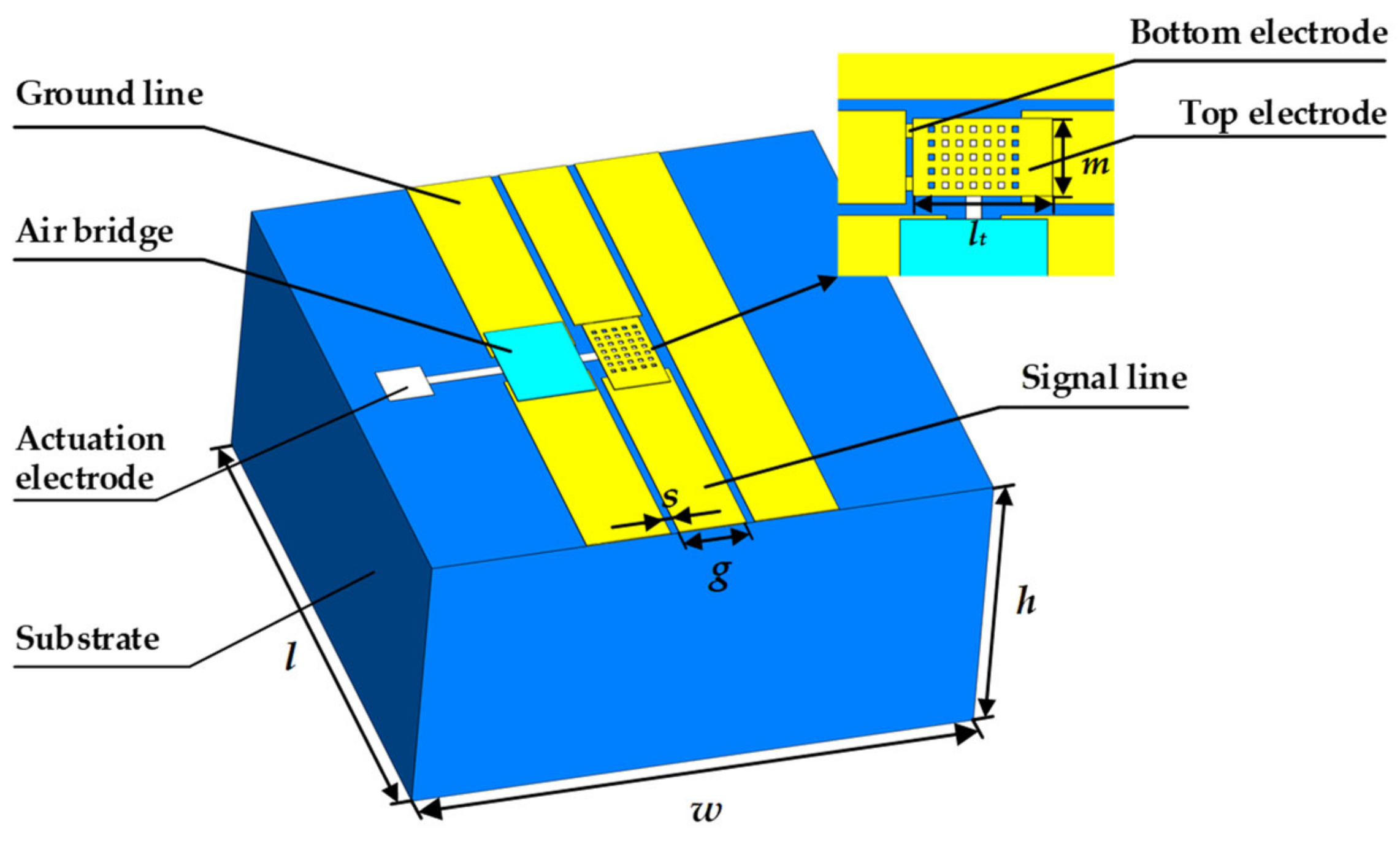
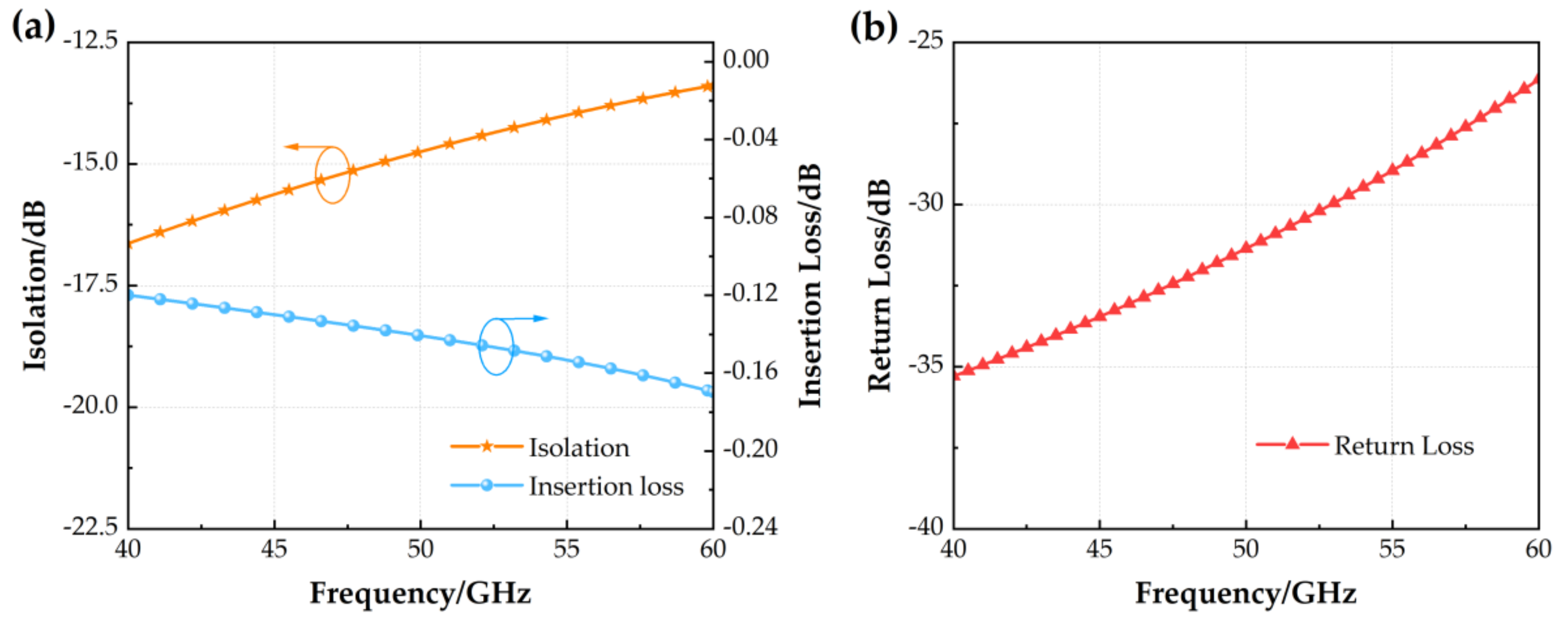

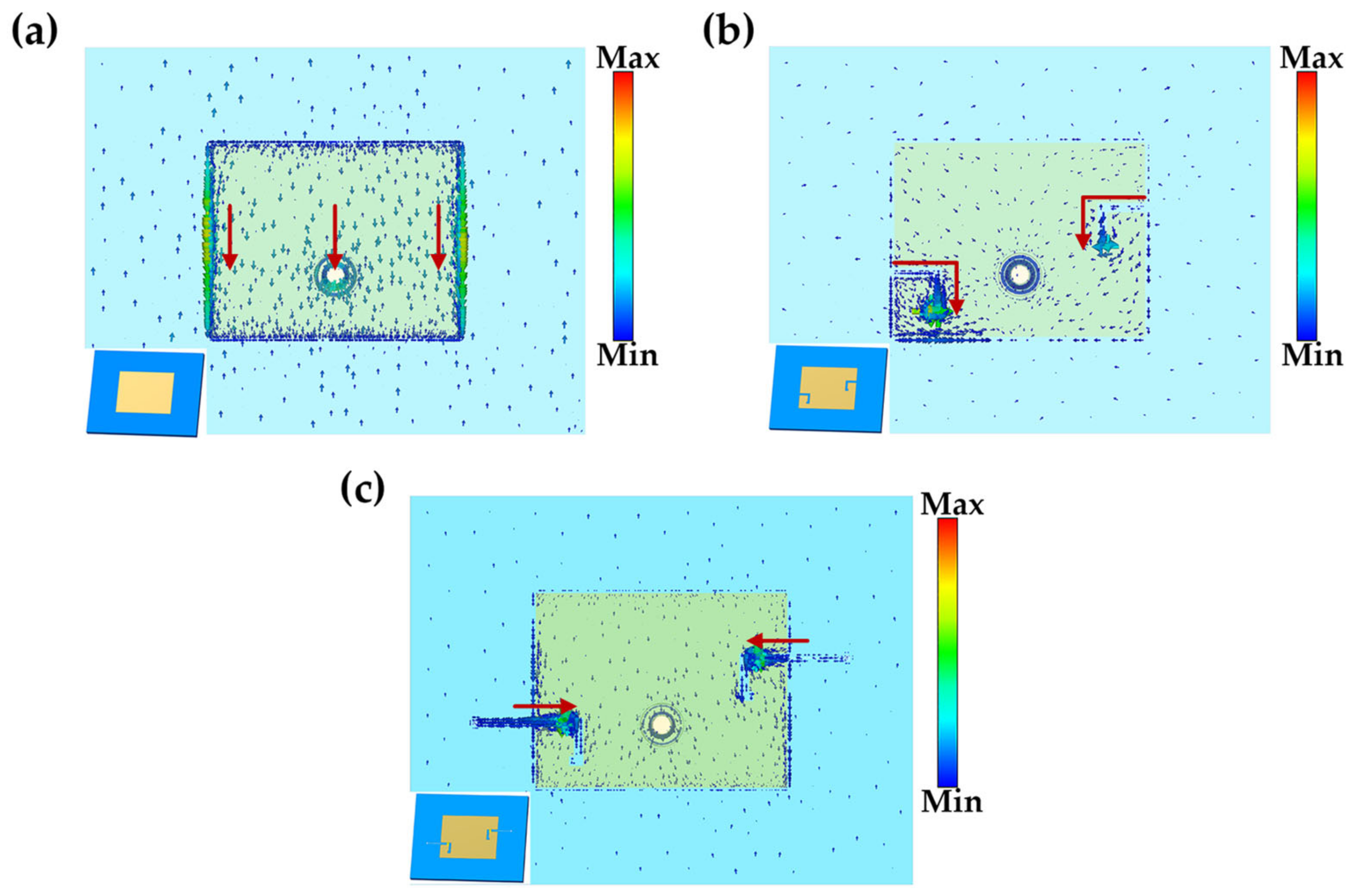


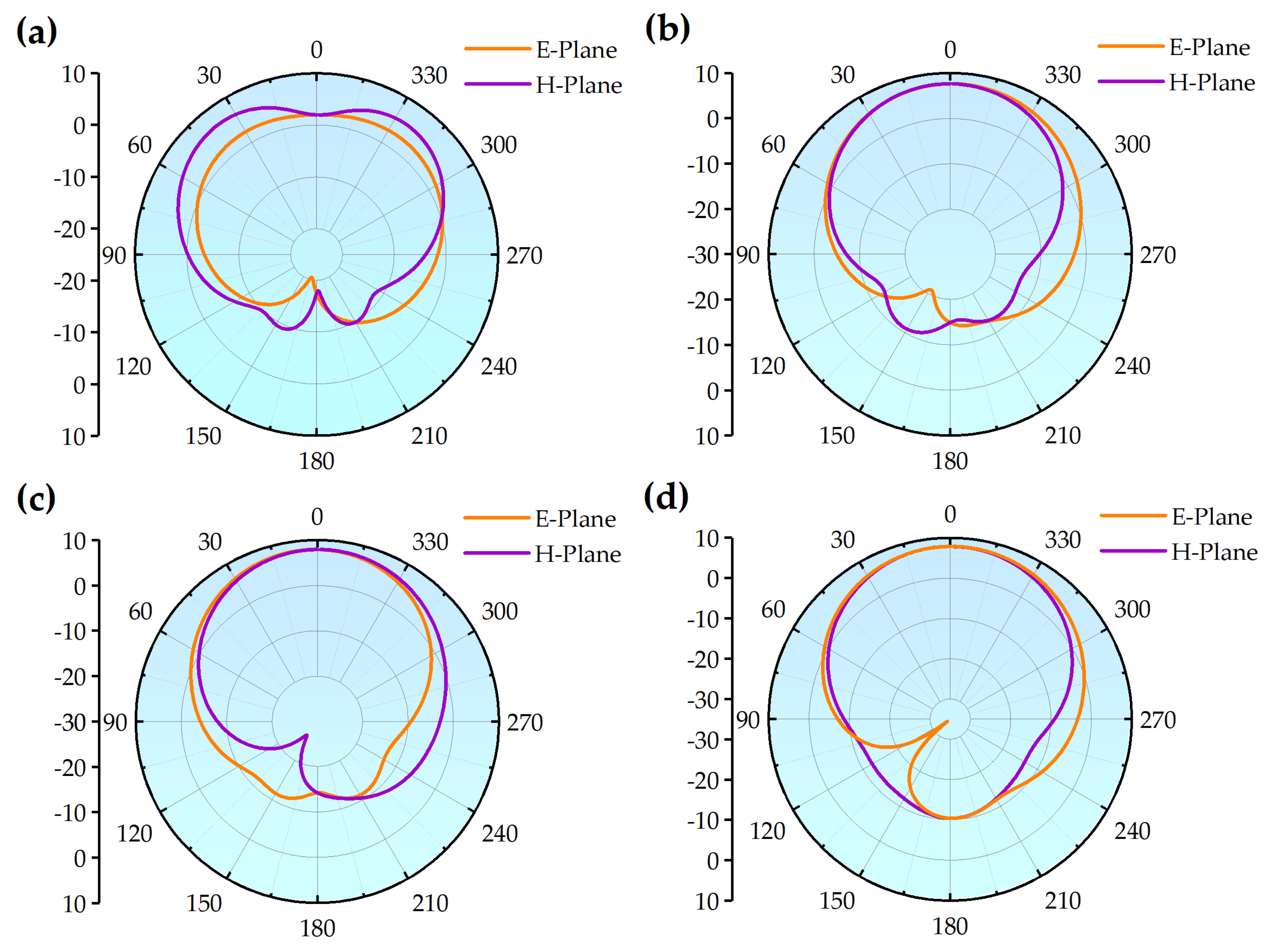
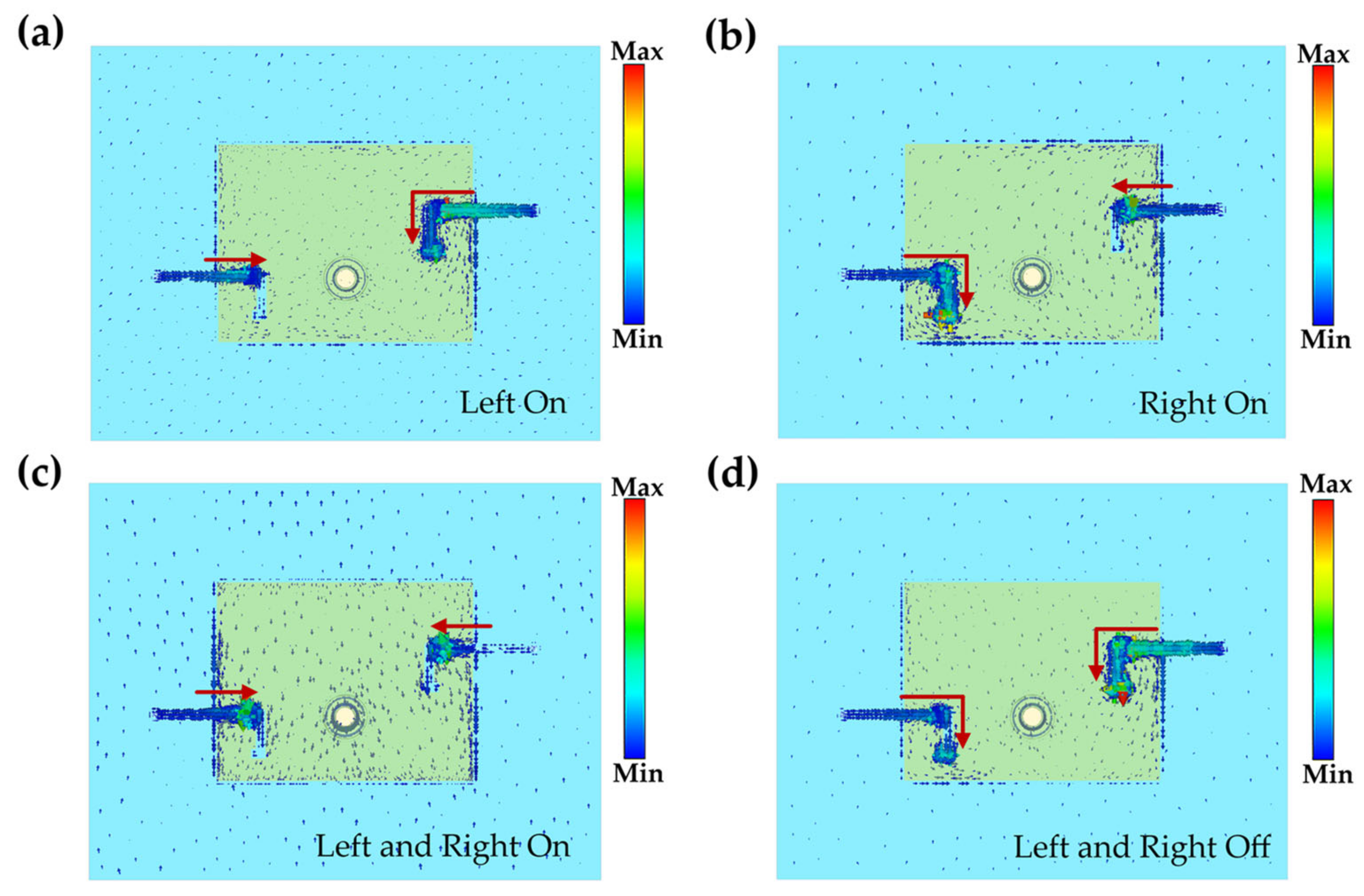

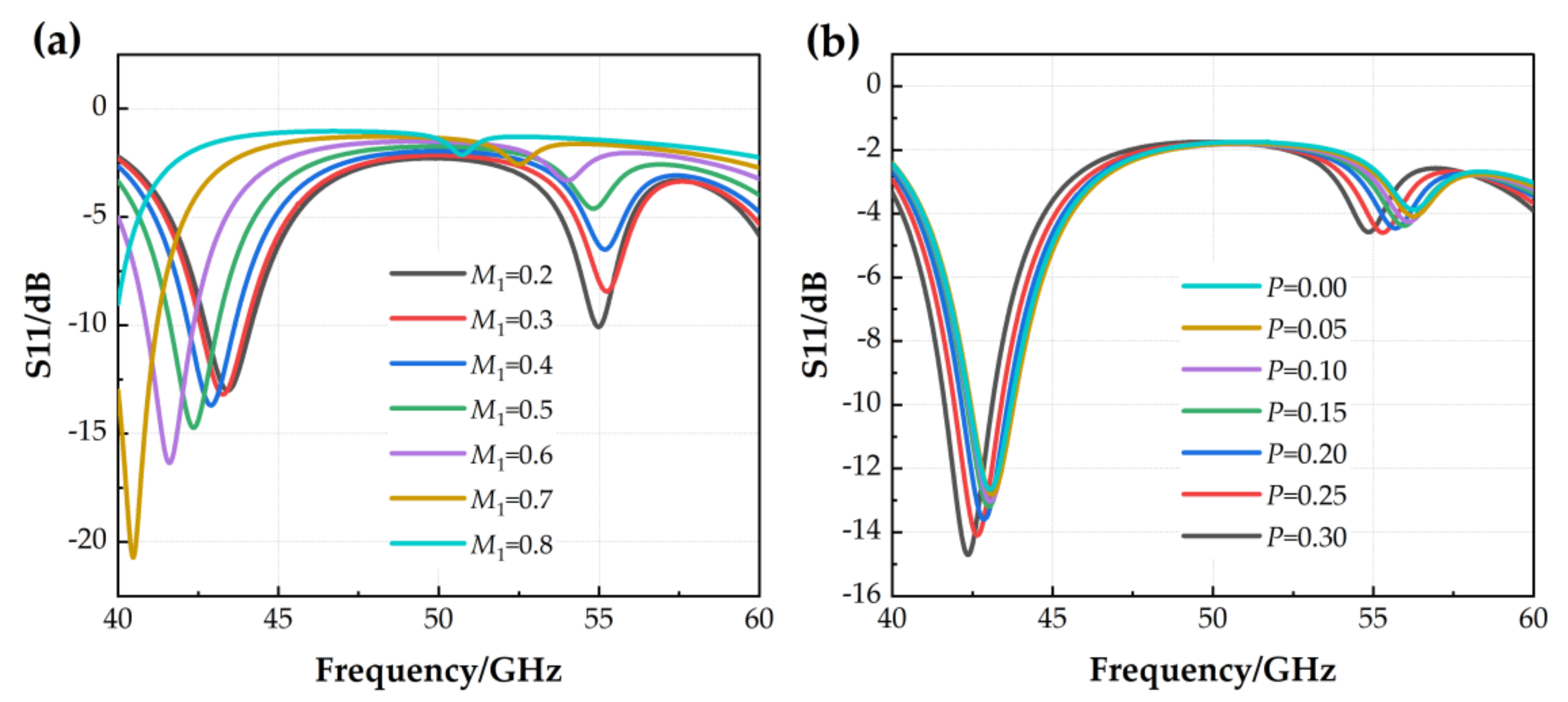
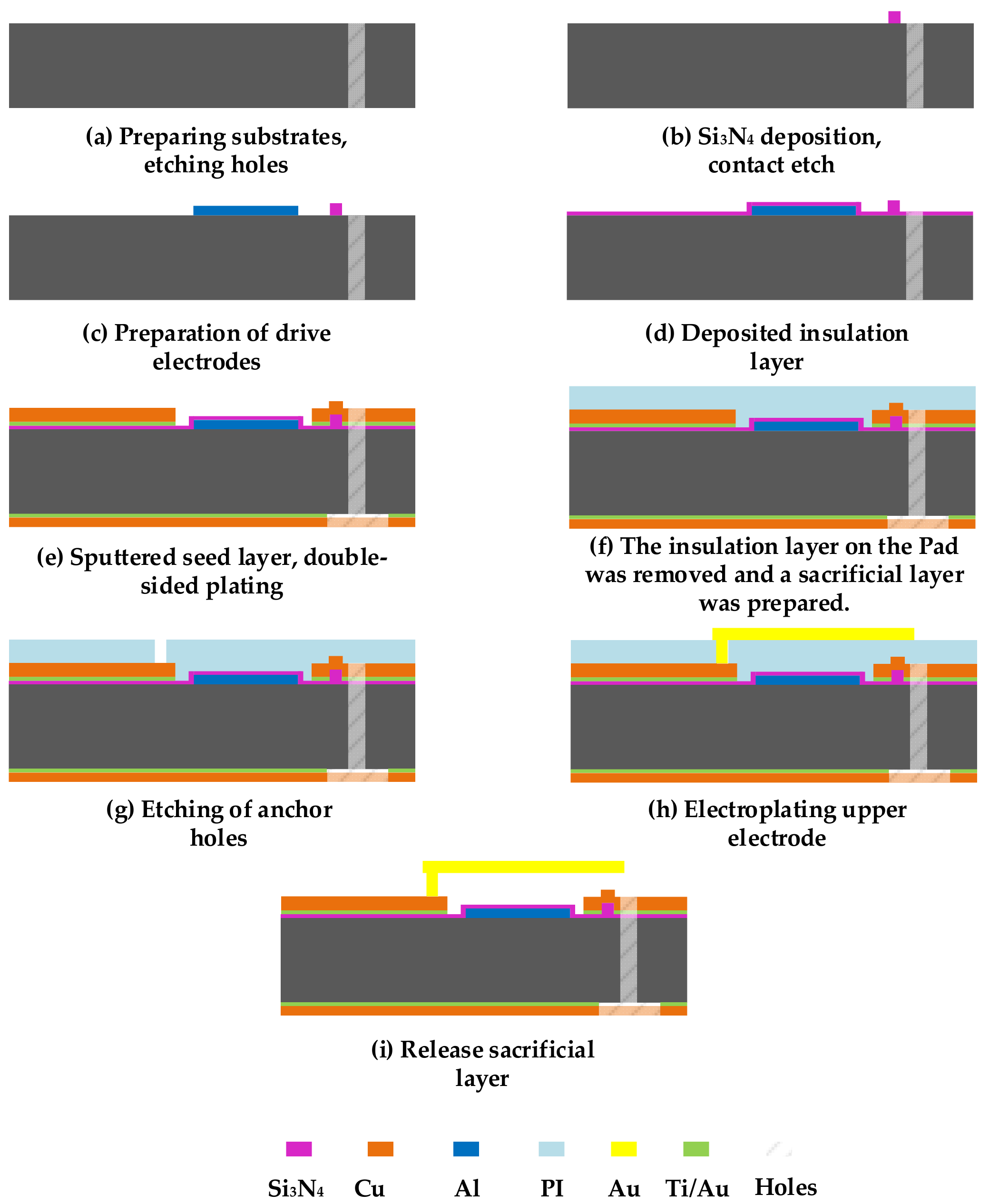
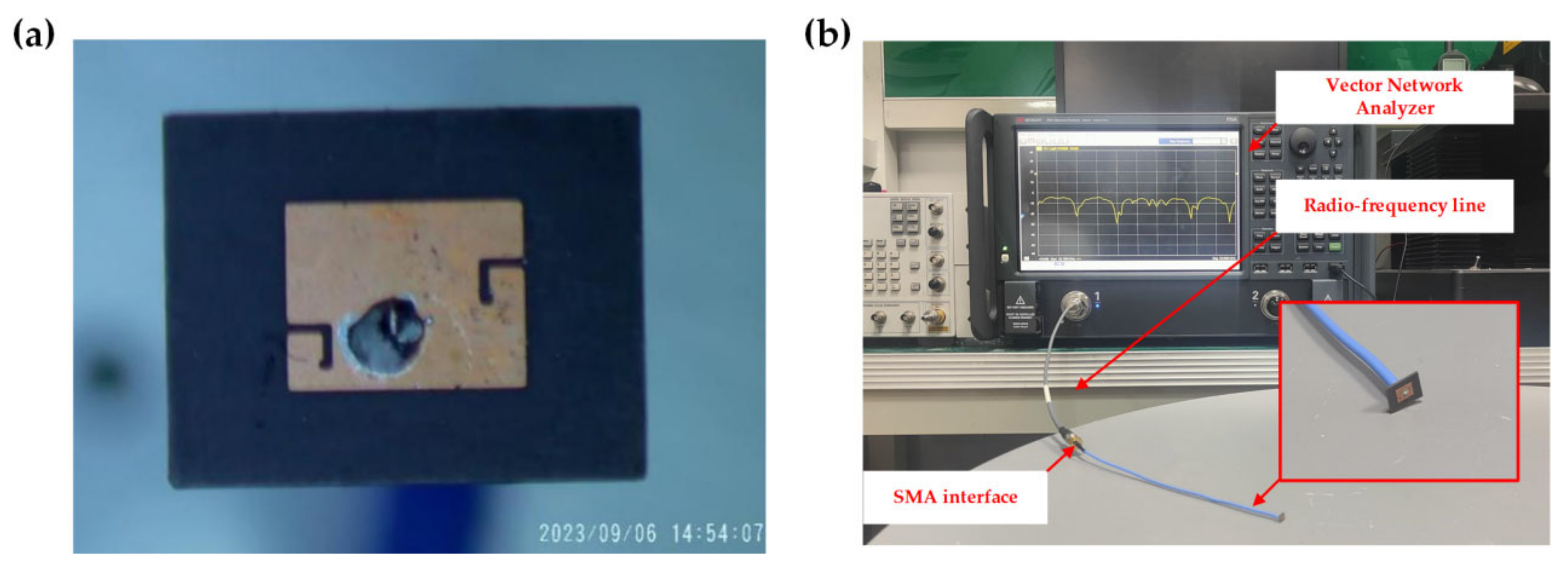
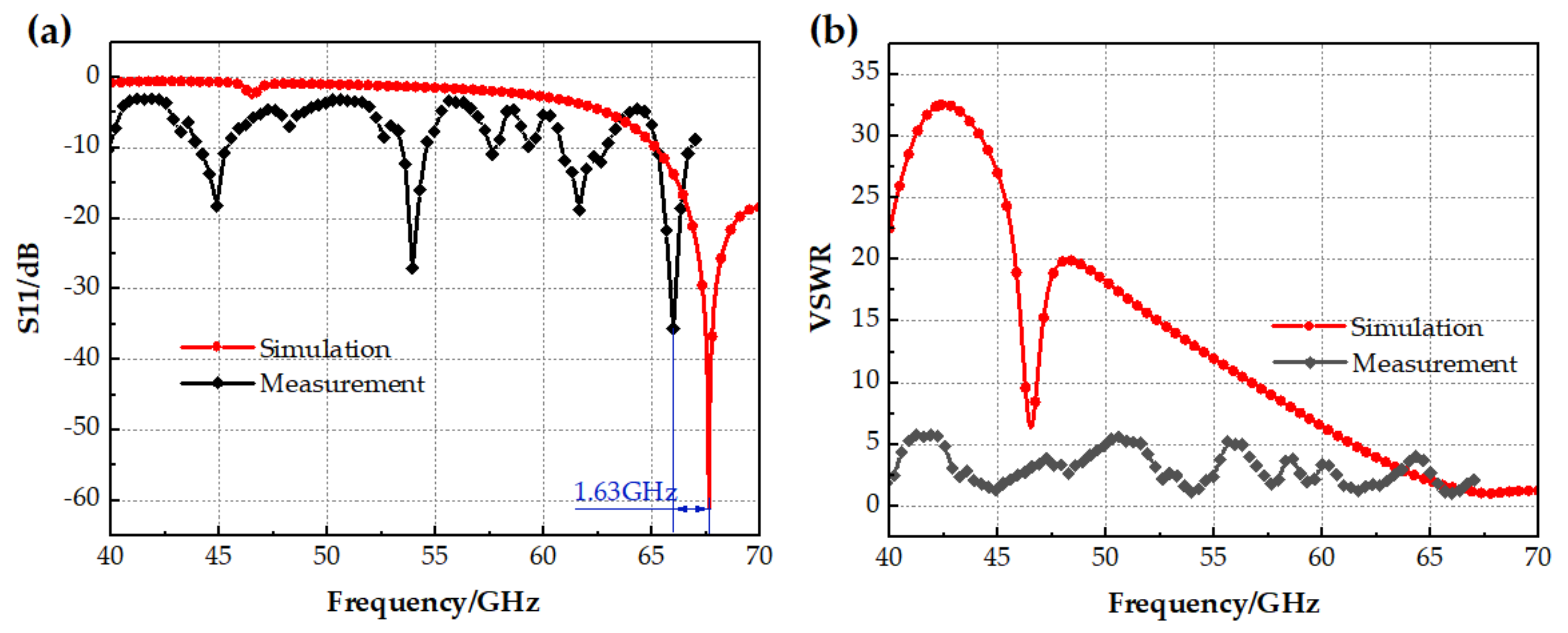
| Dimension | Value (μm) | Comments |
|---|---|---|
| g | 120 | Width of signal line |
| s | 14.7 | Distance between signal and ground lines |
| m | 100 | Width of top electrode |
| lt | 180 | Length of top electrode |
| h | 500 | Thickness of substrate |
| w | 1000 | Width of substrate |
| l | 1000 | Length of substrate |
| Dimension | Value (mm) | Comments |
|---|---|---|
| W | 5.27 | Width of antenna |
| L | 4.07 | Length of antenna |
| W1 | 2.68 | Width of radiation patch |
| L1 | 2.04 | Length of radiation patch |
| W2 | 0.10 | Width of L-slot |
| M1 | 0.50 | Length of L-slot along x-direction |
| M2 | 0.50 | Length of L-slot along y-direction |
| M3 | 0.15 | Length of L-slot folding back part |
| L2 | 1.31 | Distance of L-slot and radiation patch edges. |
| P | 0.30 | Distance of RF MEMS switch and radiation patch edges. |
| H | 0.254 | Thickness of substrate |
| Ref. | Size (mm3) | Number of Switches | Resonant Frequency f0 (GHz) | Bandwidth (GHz) | Adjustable Status | Maximum Gain (dB) |
|---|---|---|---|---|---|---|
| [15] | 10 × 10 × 0.5 | 2 | 14.25/14.5/16.3/16.4/16.65 /18.8/20.8 | 14~15.2/15.8~17.3/18.6~19.1/20.6~21 | 4 | - |
| [16] | 30 × 36.7 | 4 | 9.92/14.86/18.21/21.2 | 9.5~10.3/14.3~15.2/17.8~19/20.5~22 | 4 | - |
| [17] | 1.1 × 1.7 | 2 | 40 | 30~52.5 | 2 | 3.3 |
| [23] | 31 × 42.04 | 2 | 3.6/3.1/10/10/10.2/11.3/11.4 /11.41/14/14.1/14.11 | - | 3 | 2.27 |
| This work * | 4.07 × 5.27 × 0.254 | 2 | 42.36/47.65/53.13/56.72 | 41.63~43.11/46.76~48.60/51.88~54.51 /56.01~57.44 | 4 | 7.90 |
Disclaimer/Publisher’s Note: The statements, opinions and data contained in all publications are solely those of the individual author(s) and contributor(s) and not of MDPI and/or the editor(s). MDPI and/or the editor(s) disclaim responsibility for any injury to people or property resulting from any ideas, methods, instructions or products referred to in the content. |
© 2023 by the authors. Licensee MDPI, Basel, Switzerland. This article is an open access article distributed under the terms and conditions of the Creative Commons Attribution (CC BY) license (https://creativecommons.org/licenses/by/4.0/).
Share and Cite
Chen, Y.; Guo, H.; Liu, Y.; Li, J.; Zhan, Y.; Wu, Q.; Li, M. An L-Slot Frequency Reconfigurable Antenna Based on MEMS Technology. Micromachines 2023, 14, 1945. https://doi.org/10.3390/mi14101945
Chen Y, Guo H, Liu Y, Li J, Zhan Y, Wu Q, Li M. An L-Slot Frequency Reconfigurable Antenna Based on MEMS Technology. Micromachines. 2023; 14(10):1945. https://doi.org/10.3390/mi14101945
Chicago/Turabian StyleChen, Yu, Honglei Guo, Yanfei Liu, Jing Li, Yongxin Zhan, Qiannan Wu, and Mengwei Li. 2023. "An L-Slot Frequency Reconfigurable Antenna Based on MEMS Technology" Micromachines 14, no. 10: 1945. https://doi.org/10.3390/mi14101945
APA StyleChen, Y., Guo, H., Liu, Y., Li, J., Zhan, Y., Wu, Q., & Li, M. (2023). An L-Slot Frequency Reconfigurable Antenna Based on MEMS Technology. Micromachines, 14(10), 1945. https://doi.org/10.3390/mi14101945





